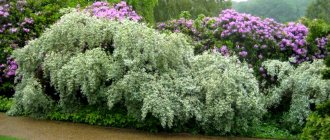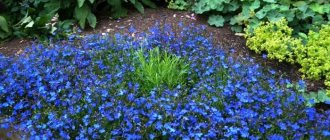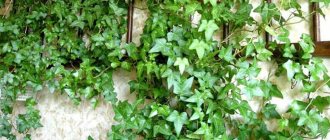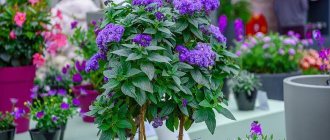For residents of the middle zone, hedera, an unpretentious evergreen ivy, is more familiar as a popular hanging plant for the home.
But in the southern regions of the country it is garden ivy. Huge thickets of this culture can be found in the Crimea and the Caucasus. As the ivy grows, it climbs inaccessible slopes and the walls of houses, covers the slopes with a dense carpet, and its shoots hang from the trees. Plants belonging to perennial evergreen vines are not capricious, not demanding in terms of growing conditions and care. They grow quickly and readily delight with decorative foliage of various shapes and colors.
It is not surprising that the plant has been noticed by gardeners for a very long time. In Europe, evergreen garden ivy, which remains attractive throughout the year, is used to decorate hedges, landscaping urban and rural buildings, parks and gazebos.
Description of varieties and varieties of evergreen ivy
Biologists know many varieties of this perennial plant that carpets mountains and plains.
Ivy has a large number of long roots, with which it clings to everything that gets in its way. Its leaves are a rich dark green color, and there are variegated varieties. You can determine which ivy is best to get for your site by looking at the photo. Gardeners plant evergreen ivy on their plots, near houses and gazebos. The following cold-resistant plant varieties are more common.
- Common ivy - planting is possible at home and in natural conditions. It grows slowly. The leaf plates are medium-sized, openwork. In open ground it is often planted to decorate paths, artificial ponds, and clearings.
- Colchis (Caucasian) ivy is planted in gardens, near buildings. It clings, grows upward and beautifully covers all the walls and supports. As they grow, the leaves become large and change their shape and color. Can grow up to 30 m long. Maintenance is not troublesome.
Colchis ivy - Crimean ivy is a heat-loving variety. If planted in an area favorable for development, they grow quickly, the trunk becomes woody over time, becomes strong and powerful. This ivy clings to trees and shrubs, quickly wraps itself around itself and grows together with them. Growing this crop will bring pleasure to the gardener.
Ivy in landscape design
Traditionally, in landscape design, ivy is used as a small, fast-growing vine, but it is no less effective as a ground cover crop. Moreover, the use does not have to be classic: vertical gardening, with enough imagination, can be unusual and even extravagant. Thanks to their talent for clinging even to smooth, rough surfaces with the help of invisible roots, ivy can climb anywhere.
For example, if you install a regular wooden trellis against a light-colored wall and, instead of a solid texture, you wrap twigs around the lattice slats, you will get a fancy pattern of green checks or diamonds. And a series of arches, squares or triangles over the path, thanks to the ivy that covers the supports, as an alternative to the usual massive green hedges, can become an elegant decoration of the garden. Of course, sometimes you will have to resort to cutting, but ivy tolerates it very well.
It is considered increasingly fashionable today to create original living frames around windows and doors, and even to imitate framed passages in the wall, allowing you to create optical illusions. As a ground cover, ivy will even help to hide communications, for example, near a fountain or pond, disguising pipes and other unattractive parts under luxurious greenery.
Ivy plants look great in flowerpots on plinths or stone bowls, allowing you to fill them with a plant that will play its role even in winter. Varieties with small lacy leaves, such as Minima, look great in mini flower beds and borders. Ivy with the brightest patterned leaves brings the effect of inner glow to shady corners, enlivening even the most boring design elements, and to potted gardens, the design of window sills, balconies and terraces - the splendor of openwork lush greenery, highlighting the beauty of summer gardens with a bright lush background.
Ivy can be used to form a green sculpture of any shape. This is a great alternative to classic topiary topiary shrubs. At the same time, creating “cut” masterpieces will require significantly less effort and time. In fact, you don’t even have to cut the ivy. Sculptures are created from potted ivy by anchoring the base of any wire frame - a ring, a ball or a complex sculpture - into the soil of the pot next to the plant.
The shoots are carefully distributed on all sides of the frame, braided with wire and, if necessary, tied with soft twine.
As the ivy grows, it is directed to the “missed” places and thus forms the entire figure completely. All that is necessary for such a sculpture to serve as a decoration for your garden for many years is to tie up the side shoots and provide the plant with proper care. In contact with
Proper planting and care of young crops
Ivy is not demanding and not capricious. It tolerates shade perfectly, loves sunlight, and is afraid of low temperatures and high humidity. If you leave it without shelter in the cold during the winter, the crop may die.
In order for the young plant to successfully overwinter in open ground, it is planted on an elevated area where there is no wind or drafts. Until the ivy gets stronger, it grows slowly. Planting should be done in early spring so that the crop has grown sufficiently over the summer and gained strength for wintering.
Ivy is planted as follows:
- prepare a well-moistened substrate, airtight, rich in organic fertilizers;
- dig a hole that is slightly deeper than the main ivy root;
- add drainage to the bottom;
- plant the crop, fill the hole with substrate, and water it.
After planting ivy in open ground, the condition of the top layer of soil should be monitored for the first time. It is important that air enters the soil and moisture penetrates. This requires proper care and periodic careful loosening of the soil; mulching can be done with any organic matter of a porous nature.
Attention! During cultivation, it is imperative to loosen the soil after rains to prevent the formation of a dense area of soil that prevents the penetration of moisture and air to the root system.
Ivy growing in open ground should not be watered too often. If rains are not a frequent occurrence in a particular region, then watering should be done 1-2 times a week in the summer; in the fall, the supply of additional moisture to the soil is reduced.
For the winter, evergreen ivy planted outside should be covered. For this, gardeners advise using plastic film or burlap. In the spring, when the snow has melted, there is no need to immediately take up fertilizer and start cutting off frostbitten and weak shoots. It is recommended to prune in June, when the sap has finished running.
How to replant ivy
The plant is replanted in several cases:
- if roots protruding from the pot become noticeable;
- if growth and development have stopped.
In addition, it is possible, without paying attention to all these factors, to replant young shoots annually. For perennial shoots, it is enough just to change the top layer of soil in the pot with freshly prepared one.
Note! The approximate composition should be as follows: leaf, peat, turf types of soil along with sand in equal proportions. The most preferable time to plant a flower is spring, namely March-April
This is very important, since planting ivy in a pot correctly is not at all easy. The container size should be approximately a couple of centimeters larger than the previously used one.
Then you need to pour a copious amount of water onto the root soil to form a lump. Next, carefully grab the stem and drag it into a new pot. Sprinkle with new soil, leaving a little space around the edges for water to drain. The last step will be to water the plant, as well as spray its leaves and stem
The most preferable time to plant a flower is spring, namely March-April
This is very important, since planting ivy in a pot correctly is not at all easy. The container size should be approximately a couple of centimeters larger than the previously used one.
Then you need to pour a copious amount of water onto the root soil to form a lump. Next, carefully grab the stem and drag it into a new pot. Sprinkle with new soil, leaving a little space around the edges for water to drain. The last step is to water the plant and spray its leaves and stem.
Important! It is best to keep a newly transplanted flower away from drafts and also away from direct sunlight.
Plant propagation methods, necessary fertilizers
Growing ivy is very easy. Gardeners recommend doing this in the spring or early summer. For propagation, apical branches that have begun to become lignified are selected. If you take a young shoot, its rooting and subsequent growth will take longer, and the plant does not always take root.
Planting ivy
When cutting cuttings for propagation (approximately 10 cm long), it is necessary that there are healthy nodes on each shoot. First, they are planted in greenhouses using very loose, moist soil, or dipped in water for a while until the root grows. Afterwards, they can be transplanted to a permanent location in open ground. After propagation, each cutting is planted at a distance of a meter from the neighboring plant.
You can propagate ivy using a whole shoot. To do this, you need to perform several steps:
- take an ivy shoot that has at least eight leaves growing on it and place it, pressing it slightly, on the sand so that all the leaves remain on the surface;
- during cultivation, water moderately, do not allow the sand to dry out;
- after 7-10 days, the aerial roots located in the sand will turn into underground ones;
- carefully remove the ivy and cut the shoot so that each cutting has its own leaf;
- plant the sprout in open ground or in a pot, do not forget about fertilizers.
In order for garden ivy to please its owner, the plant must be fed every two weeks in the spring and several times during the summer. It is better to do this after watering. For feeding, gardeners advise using mullein mixed with water, or mineral fertilizers for ornamental plants, which can be purchased at a specialty store.
Propagation of frost-resistant ivy
The plant is very easily propagated by cuttings. Once the shoot is placed in water for several days, it begins to form roots. This ability allows you to quickly grow several seedlings of the same variety, which are required for landscaping the garden.
Rooting ivy cuttings in water
The liana is characterized by slow growth, so you will have to wait several years for long shoots. Planting of seedlings is carried out in early autumn so that the vine can take root before frost. The young plant is covered with spruce branches or leaves for the winter.
The second method of propagation is simpler and more effective and is most suitable for those who want to form a continuous green curtain along one surface.
It is enough to sprinkle the ivy cuttings with soil, and soon they will form roots at the nodes and begin to form as independent plants.
Formation of roots on a vine layer
Rooted cuttings can be separated from the parent plant and transplanted to a new location.
How to recognize diseases and notice pests. Combination with other plants
Ivy is considered an unpretentious plant, but it can get sick or be captured by pests at any moment. It is important to promptly recognize that the plant needs help and take all measures to cure it.
Advice. If the ivy is attacked by pests or disease, it is necessary to inspect all nearby crops.
- If the leaves begin to turn yellow and fall off, the cause must be sought in dry soil. Having received sufficient watering, very soon the ivy will acquire new foliage.
- If the stems lose their green leaves and quickly become bald, the ivy does not like the air. Typically, this phenomenon can occur in hot summer or autumn. Therefore, the gardener is recommended to give his plant water treatments every day.
- It’s a bad sign if the variegated and bright green leaves suddenly fade. The root cause is that the plant receives little light. The problem can only be solved by planting in a new, more illuminated place.
Ivy growing in open ground cannot be protected from pest attacks. Aphids, scale insects, and mites are carried by insects and wind. If you find parasites on the leaves or stems, you should immediately begin the fight. To overcome them, it is necessary to spray ivy and all nearby crops with actellik diluted with water or karbofos. After the first spraying, it may not be possible to completely get rid of pests. In this case, the procedure should be repeated after a few days.
Ivy will perfectly decorate hedges
This plant is often planted near the fence, near the house, around gazebos. Photos of buildings overgrown with ivy can be seen in magazines. Ivy, if you guide the branches along supports as it grows, will become a worthy decoration for your garden plot. It is not afraid of any neighbors growing nearby, but not all plants are compatible with ivy and can coexist with it in the same area.
Coniferous, deciduous trees and ornamental shrubs will be comfortable next to ivy. Landscape designers present the idea of a combination and recommend planting this creeping plant in a garden with roses. Dark or variegated ivy greens will beautifully highlight the base of the queen of flowers.
Garden ivy, when it grows and gains strength, becomes very beautiful. When starting such a plant, you should be prepared that in order to give it a neat, aesthetic shape, the plant needs to be pruned regularly. Especially if it stretches up along supports, walls of the house, or fences. Otherwise, caring for the plant is simple. By choosing the right place on the site, organizing watering, timely fertilizing and testing the propagation of the plant in practice, within a season you can become the owner of incredibly beautiful garden ivy.
Ivy in the country
The best shrubs and trees are always planted on a summer cottage. A climbing vine will decorate a place that is used for relaxation.
How to plant ivy on a plot
Many gardeners are interested in how to grow variegated garden ivy. It is better to plant cuttings in spring in breathable and nutritious soil to a depth of 15-20 cm.
Note! If the soil is heavy, you need to dig a hole a little deeper and make drainage from expanded clay or broken bricks.
The young plant should be directed towards a support or fence. Watering is carried out moderately so that there is no stagnation of water. You can fertilize the vine with organic fertilizer once a month. Before winter, shoots should be covered to prevent frostbite of the stems and roots.
Use in landscape design
Evergreen vines attract attention due to the variety of colors and shapes of the leaves. Designers use the plant to decorate vertical surfaces:
- sculptures;
- house walls;
- arches
Note! When creating a structure, it is necessary to constantly direct the growing shoots in the right direction.
Combination with other plants
Common garden ivy can be combined with other plants that can embody any design ideas. The liana is planted near roses, flowering shrubs and coniferous trees. As a result, the gardener gets ivy climbing along the wall, which is pleasing to the eye.
How to prevent the growth of garden evergreen ivy
Gardeners are not always happy about the intensive growth of the plant, which begins to entwine nearby trees and bushes. To get rid of ivy, you need to cut it off at the very root, dig up the entire root system and make sure that there are no shoots left on the ground. Sometimes herbicides are used.
Following the rules of care, planting and propagation will allow you to achieve good results. Evergreen ivy will grow quickly and beautifully. With the help of the plant, they create an original landscape design, decorating hedges, other shrubs and even the walls of the house with greenery.
Garden ivy: photo
How to grow ivy and how to care for it
Common ivy is an unpretentious perennial plant that grows on all types of soils, is drought-resistant and light-loving, and tolerates frost well. Although it can grow in deep shade, tolerating heavy shade, it grows faster when exposed to direct morning or evening sun.
With a lack of light, the variegated color of the leaves fades and even disappears, but they should be protected from direct sunlight. Almost any soil is suitable for common ivy, with the exception of clay. It grows well in fertile and sandy soil; a clay mixture is best.
https://youtube.com/watch?v=oPFDF6LsUow
Irish ivy is more frost-resistant than common ivy, but suffers from frost. It tolerates partial to full shade, but can burn in full sun. Grows on all soils except pure peat.
When caring for ivy in the garden when growing a hedge, supports are prepared in advance. These could be poles with wire stretched across them, or a wooden fence, or a metal or plastic mesh.
Light-loving plants can be recognized by the color of their foliage. They typically have light green and variegated leaves and grow best in strong light.
To plant ivy, dig holes along the supports so deep that the roots of the seedling can completely fit into them. Planting holes are dug at a distance of approximately 50 cm from each other.
The bush is planted obliquely so that, once rooted, the plant can climb onto the necessary supports or stones. At least 25 rooted cuttings are planted for each m2. After planting, the seedlings must be watered.
The growing shoots are directed to a support that is supposed to be landscaped. After planting ivy, if properly cared for over the summer, it will spread over the supports like a dense wall and become a reliable protection from wind and dust.
Ivy seedlings with a closed root system are planted from March to November, including on hot summer days, without purchasing additional fertilizers.
Watering ivy during care when growing in the garden is necessary within reasonable limits so that the plant has enough moisture and the soil does not dry out. The soil should be moist, but should not be over-watered.
In hot, dry weather, at temperatures above +21 ° C, it is recommended to spray the ivy leaves from above, which will allow them to maintain freshness and purity. In addition, regular spraying with water will protect the plant from red spider mites.
Pruning of fast-growing ivy is carried out regularly, removing excess shoots, dry and damaged. Systematic pruning and shortening of unevenly growing shoots allows you to keep ivy within the established contour of the fence.
These photos show techniques for caring for ivy in outdoor conditions:
To protect garden ivy in winter, the soil under it is mulched in the fall with a sufficient layer of peat or humus so that it does not freeze. Ivy stems on low borders are covered for the winter with dry leaves of apple, hazel or oak.
Ivies are rarely affected by insect pests or diseases. However, common ivy can sometimes be affected by spider mites.
Irish ivy is damaged by scale insects and mites. For prophylaxis when caring for ivy, plants are regularly, but within reasonable limits, sprayed with an insecticide in the dose indicated on the package.
Treatment with karbofos, Aktara, and Aktellik (1-2 ml per 1 liter of water) gives good results against scale insects, spider mites, and aphids.
If the ivy is infested with spider mites, then silvery dots will appear on the front side of the leaves, and spider threads will appear below. In this case, they are sprayed with water and treated with a special preparation against pests.
Controversial plant
While ivy is undoubtedly a wonderful plant to form dense carpets or green walls, its aggressive spread has put many off. There are those who consider ivy to be a weed that needs to be eradicated because it is harmful to buildings and the environment. There is some truth in this, since it is a highly invasive species, very resistant to external influences, undemanding to soil composition and capable of choking out weaker plants. But with controlled growth and regular pruning, it can be grown quite well. It does not form rhizomes and does not grow from underground lateral roots. Therefore, it is enough to trim the length of the shoots so that they do not grow too much, and you can safely admire the charm of their leathery green leaves all year round.
Getting rid of ground ivy using the darkening method
Ground ivy, like other plants, needs light to grow. This method deprives the plant of sunlight. However, it can survive even in low light and dense shade. For this reason, it is completely isolated from light.
Step by step execution:
- It is necessary to darken the area affected by ground ivy. There are many ways you can do this. For example, placing a large piece of cardboard, fabric or tarp over the vegetation to completely block out the light.
- If ground ivy is growing among other plants that you want to keep, you can make a round hole in the fabric or heavy tarp for it. This will prevent light from reaching the ivy, but the desired plants will not be harmed. Any surrounding vegetation that is deprived of sun will die along with the ground ivy.
- It is necessary to secure the lightproof coating well from external influences. Otherwise, wind, animals or other environmental factors may change its position. To stabilize the sheet, earth, stones or other weights are placed at the corners and edges of the sheet to keep it in place.
- To completely prevent light from entering, you should ensure that the cardboard or tarp is large enough to cover at least 15 cm of additional space beyond the intended area.
- Now you should wait until the ivy dies. In many cases, a week of such exposure will cause the plant to wilt and die, although sometimes it takes longer, depending on the nutritional status of the soil and other factors. You need to periodically look under the cover to see if the ivy has died.
- When it becomes noticeable that all the stems have dried out, shriveled and lost their greenery, the plant has died.
- Remove the plant from the soil. There is a risk that the ivy will recover even after the bush has died. To prevent re-sprouting, you need to collect all plant fragments, including roots, and get rid of them (take them outside the site or burn them).
- When in direct contact with ivy, be sure to wear gloves. Many people are allergic to this plant.
Why is ivy removed from the walls of buildings?
From an aesthetic point of view, ivy is a beautiful addition to the home. However, if not taken care of properly, it can also become his curse. Neglecting this plant on the facade can lead to:
1. Destruction of walls - due to the emerging ecosystem and the mosses and algae contained in it. And if the plant nests in a gutter, a real tree can grow there. This is due to the lack of water drainage (the drainage system is clogged with ivy) and ideal conditions for the development of seeds carried by the wind or birds. When the tree, in turn, begins to grow, its root system can completely destroy the wall.
2. Many living organisms settle inside the plant, for example, mosquitoes and snails, attracted by ideal living conditions.
Magical properties of ivy
According to some signs, the coil has negative potential. Liana is considered an energy vampire. It is advisable to keep the plant in families with an unfavorable emotional background. The leaves absorb negativity after quarrels.
The coil protects the owners of the house from evil people and cleanses the atmosphere. It is advisable to place it near the computer in the office. It is not recommended to place the pot in residential premises.
Unmarried girls are advised to purchase the plant. The coil helps to overcome uncertainty. If a vine is planted by a married woman, the liana will become a kind of shield against quarrels between spouses.
Wreaths were formed from serpentine leaves, which the ancient Greeks wore on their foreheads as a preventive measure against alcohol intoxication. The liana was a symbol of fidelity. A wreath made of serpentine vine was presented to newlyweds as a wedding gift.
Roman women wore a twig on their chest. It was pinned to clothes as decoration. The ritual made it possible to preserve youth and beauty.
Methods of preparation and use
The extract in the form of tablets, mixtures, syrups can be purchased at the pharmacy. Medicinal compositions are also prepared independently.
Ivy tincture
An alcohol solution is used for coughs. It includes:
- dried and crushed leaves - 100 g;
- vodka - 500 ml.
The product is easy to prepare:
- The raw material of the coil is filled with an alcoholic drink.
- The mixture is infused for 20 days.
- Before use, the drug is filtered.
The tincture from the serpentine is drunk on an empty stomach, 20 drops three times a day.
Ivy decoction
To prepare an aqueous solution take:
- 1 tsp. dry raw materials;
- 250 ml boiling water.
The product is prepared as follows:
- Serpentine grass is poured with boiling water and placed on fire.
- After ten minutes, the drug is filtered.
A decoction of ivy is drunk at one time to treat gastritis, joint diseases, and inflammation of the appendages.
Important! An aqueous solution is effective for helminthic infestations, constipation, and high blood pressure.
Serpentine decoction can be used externally. It is used to treat purulent wounds for the purpose of disinfection. An aqueous solution is applied to burns. Douching is beneficial for gynecological diseases.
Chemical composition
The above-ground parts of the plant are used for medicinal purposes. Leaves, flowering shoots include:
- sterols;
- glycosides;
- resins and tannins;
- coumarins;
- carotenoids;
- tocopherol;
- ascorbic and organic acids;
- iodine;
- phenolic compounds;
- pectins.
The seeds contain oily substances. Flowers are a source of triterpenoids.
Serpentine is a poisonous plant. The oily substance secreted by the leaves causes an allergic reaction in most people.
How to remove ivy
Sometimes the question arises of how to remove this plant, for example, from the garden. Since ivy grows very quickly, it begins to interfere with and clog other plantings. In addition, if there are children in the house, then it becomes necessary to protect them from poison ivy berries. So, what needs to be done for this:
- use garden shears to remove the ivy from the support;
- Using pruning shears or a hacksaw, if the shoots are too thick, cut off the main part of the ivy at the surface of the soil;
- dig up and dispose of the rhizome, do not leave shoots, otherwise they will quickly take root;
- When young shoots appear, use the herbicide “Tornado”.
In many European countries, thanks to the rather moderate warm climate, you can find huge thickets of garden ivy. There it pleases the eye all year round with its fresh, bright appearance and a wide palette of foliage of different shapes and colors. If you are thinking about decorating your own home or garden, then garden ivy will be an excellent choice. And for residents of the northern regions he will create a real home winter garden.
Home page » Garden ivy is an evergreen decoration for your garden. Tips for growing and caring
Ivy occupies a special place among garden plants. Many landscape designers choose this particular plant to design hanging gardens. In the courtyards of houses it is used as a hedge. Ivy is very good for decorating gazebos, arches, hedges and even walls. Evergreen garden ivy is also used when creating an English-style garden.











